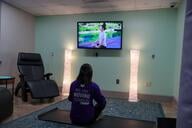You have /5 articles left.
Sign up for a free account or log in.

ISTOCK.COM/sorbetto
Several community colleges are reporting record fundraising for fiscal year 2020, which ended at the start of July for most.
The COVID-19 pandemic seemed to help, rather than hinder, efforts to boost emergency aid funds and scholarship budgets.
Charitable giving over all -- not just for higher education -- is up 7.5 percent for the first half of 2020 compared to the first half of 2019, according to the Fundraising Effectiveness Project.
"Really what was driving a lot of that was small donations," said Brian Flahaven, interim vice president of strategic partnerships for the Council for Advancement and Support of Education. "My feeling is that community colleges were really good at focusing on, 'We need support to help students now.'"
Focusing on emergency aid in the midst of a pandemic is a smart strategy, Flahaven said, as it's an appealing message to donors. The question is whether this momentum will continue.
"There’s certainly concern about whether those are sustainable," he said. "There may be increases now, but uncertainty is the enemy of giving."
Outsize Results
Harper College in Illinois raised $120,000 during a six-week campaign in June and July. The board of the Harper College Education Foundation gave an additional $40,000, and the college matched the donations. In total, the foundation raised more than $300,000 for an emergency fund in that one campaign, said Laura Brown, chief advancement officer at the foundation and vice president of marketing and communications at the college. Every board member donated something, and some individual donors gave multiple times.
Over FY 2020, the college surpassed its fundraising goal by 215 percent without a previously planned campaign.
Since July 1, the start of Harper's fiscal year, the college has raised enough to already be at 53 percent of its fundraising goal of $1.8 million.
Brown credits some of the success to timing. The foundation had just completed a major giving campaign in 2019 and had spent much of the start of 2020 stewarding its donors to build relationships and retain them.
The foundation also doesn't rely on events for donations -- which helped when the virus struck and shut down virtually everything, she said.
Brown did see some surprises, though. The last financial year saw a 62 percent increase in alumni giving, including those who are recent graduates. More people became interested in establishing endowed scholarships, which start at $10,000, resulting in $170,000 raised in one year for new endowed scholarships.
"Some of our retirees are stepping forward and saying they want to do a planned gift or a scholarship," she said. "They’re recognizing that, during these turbulent times, the need is even greater."
The foundation usually gets about 60 new donors each year, but it got 150 in fiscal 2020.
"To get a significant increase in one year and not be in a campaign is remarkable," Brown said.
GiveCampus, a software and consulting company for fundraising in education, is also seeing significant increases for its community college clients. The company helps educational institutions target donors through social media and accepts gifts securely online, in exchange for an annual fee based on the institution's size and budget. It has about 1,000 clients so far.
"When COVID-19 first struck in March and April, and the country locked down, we saw a pause in fundraising activity. It wasn’t a great time to be asking people for money," said Kestrel Linder, co-founder and CEO of GiveCampus.
Since the end of April, institutions have picked back up. Community colleges have had the most outsize results of all education sectors compared to last year, Linder said. They raised 47 percent more in the first nine months of 2020 than they did in all of 2019.
Portland Community College in Oregon started hosting campaigns with GiveCampus in 2019. The college outraised its goal last year by more than $20,000, said Christina Kline, assistant director of the foundation.
This year, it's done even better. It outraised its goal for a one-day giving campaign by nearly $70,000, she said.
The average size of donations went down, Kline said, but the college more than doubled its number of donors.
"For people who were employed, whose families were safe, they wanted to support others being impacted," she said. "The community wants to support those who need an extra hand right now."
Some longtime donors have even reached out to say they can't give right now but will in the future when things are more certain.
Milwaukee Area Technical College in Wisconsin is also having a strong year, according to Laura Bray, vice president of college advancement and external communications.
The college has raised 147 percent more so far this year than it during the same time period last year. It's at 63 percent of its goal so far.
But Bray almost set a smaller goal after the pandemic struck. She was nervous about its effects. After a talk with the college president, she decided not to.
"We have to set a goal that the students deserve, because we need to engage the community to support the students like they never have before," Bray said.
The community is responding. Appeals to fund specific needs for students, like emergency funds, have worked well. Some donors who had already given for the financial year stepped forward again, she said.
The college also started a Healthcare Heroes Fund to raise money for students to pay for licensing exams so they could enter health-care fields.
Advancement staff at the college are becoming more proactive -- a trend Bray is seeing at many community colleges.
"I'm feeling a lot of overall community recognition of the important role that community colleges play in making college affordable," she said.
The Impact of a Dollar
Fiscal year 2020 was a record year for Wake Technical Community College in North Carolina, said Scott Ralls, the president.
"As we moved into the COVID-19 part of the year in March, April, May, we saw no less and probably even more enthusiasm about Wake Tech," Ralls said.
Some donors were concerned about when to make gifts, but there's more certainty now, he said.
"I think people see our purpose and our role and mission more than ever," he said. "The road to recovery in our region runs through Wake Tech, and I think supports in our community see that."
The college raised $7.1 million -- $800,000 more than it did in the prior fiscal year, according to Matt Smith, vice president of development and strategic partnerships at the college.
"Anecdotally, I would say that our spring was stronger than prior years," he said. "We would call corporate donors for gifts, and several times, unprompted, they would double or triple their gifts."
Smith heard from many corporate donors that they had extra room in their budgets due to canceled travel and conference plans. However, everyone told him that this fiscal year will be tighter. The college's fundraising is lower, at $6 million.
Smith hopes that foundations, many of which invest funds in the now-rebounded stock market, will step up to fill the gaps.
"A dollar invested in a community college really has a massive impact that I think is very special and unique," he said.
Many colleges created special campaigns or funds to address issues of the pandemic. Westchester Community College, part of the State University of New York system, is in Westchester County, which was the original epicenter of the pandemic, according to Eve Larner, executive director of the Westchester Community College Foundation.
The college created an emergency fund, which supported a laptop loaner program and basic needs support, that received a great deal of support.
"It was inspiring to see how past supporters of the WCC Foundation, and many new ones, stepped up to do what they could to help," Larner said in an email.
Westchester has relied on in-person events for fundraising in the past, though, which creates some concern for the future, she said. The foundation plans to pivot events to virtual formats.
Several colleges, including Wake Tech, are also building stronger planned or estate gifts programs.
"It doesn’t help us initially, but we think this is when people are taking a critical look at preparing for future," Smith said.
Jacqueline Cruz, vice president of advancement and develop at Hartnell College in California, is seeing the same trend.
"People are really thinking about the future," Cruz said. "These catastrophic events cause people to think about when they’re not here."
Hartnell College saw an increase in donors in FY 2020 compared to 2019, and a slight increase in the amount it raised. It received about $20,000 less than last year at its annual signature event, which was held in May and had to go virtual.
The event includes a live auction, which typically generates a great deal of revenue, but it was difficult to do remotely, she said.
She's keeping a director position at the foundation open, in case the recession and pandemic catch up with the fundraising world this year.
"The challenge is being fiscally prudent, but doubling down on your efforts," she said. "It’s a good wake-up call for us, that we’ve got a powerful mission and a powerful cause."




